STS-33
STS-33 was a NASA Space Shuttle mission, during which Space Shuttle Discovery deployed a payload for the United States Department of Defense (DoD). It was the 32nd shuttle mission overall, the ninth flight of Discovery, the fifth shuttle mission in support of the DoD and the last Shuttle launch of the 1980s. Due to the nature of the mission, specific details remain classified. Discovery lifted off from Launch Complex 39B at Kennedy Space Center (KSC), Florida, on 22 November 1989 at 7:23:30 p.m. EST; it landed at Edwards Air Force Base, California, on 27 November 1989 at 7:30:16 p.m. EST.
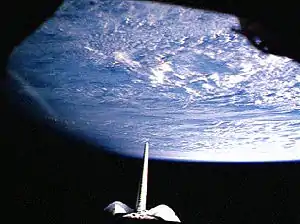 Discovery in orbit; in-flight photography on this Department of Defense (DoD) support mission is limited. | |
| Names | Space Transportation System-32 STS-33R |
|---|---|
| Mission type | DoD satellite deployment |
| Operator | NASA |
| COSPAR ID | 1989-090A |
| SATCAT no. | 20329 |
| Mission duration | 5 days, 0 hours, 6 minutes, 48 seconds (achieved) |
| Distance travelled | 3,400,000 km (2,100,000 mi) |
| Orbits completed | 79 |
| Spacecraft properties | |
| Spacecraft | Space Shuttle Discovery |
| Landing mass | 88,125 kg (194,282 lb) |
| Payload mass | 21,000 kg (46,000 lb) |
| Crew | |
| Crew size | 5 |
| Members | |
| Start of mission | |
| Launch date | 23 November 1989, 00:23:30 UTC |
| Rocket | Space Shuttle Discovery |
| Launch site | Kennedy Space Center, LC-39B |
| Contractor | Rockwell International |
| End of mission | |
| Landing date | 28 November 1989, 00:30:18 UTC |
| Landing site | Edwards Air Force Base, Runway 4 |
| Orbital parameters | |
| Reference system | Geocentric orbit |
| Regime | Low Earth orbit |
| Perigee altitude | 519 km (322 mi) |
| Apogee altitude | 519 km (322 mi) |
| Inclination | 28.45° |
| Period | 88.70 minutes |
| Instruments | |
| Air Force Maui Optical and Supercomputing observatory (AMOS) Enhanced Longwave Spectral Imager (ELSI) | |
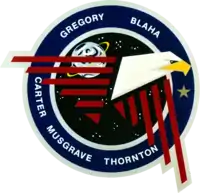 STS-33 mission patch 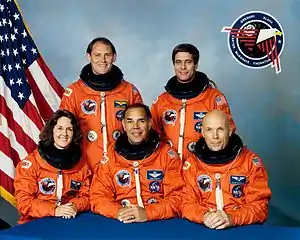 Back row: Manley L. Carter Jr. and John E. Blaha Front row: Kathryn C. Thornton, Frederick D. Gregory, F. Story Musgrave | |
The mission was officially designated STS-33R as the original STS-33 designator belonged to the ill-fated Challenger STS-51-L, the 25th Space Shuttle mission. Official documentation for that mission contained the designator STS-33 throughout. As STS-51-L was designated STS-33, future flights with the STS-26 through STS-33 designators would require the R in their documentation to avoid conflicts in tracking data from one mission to another.
Crew
| Position | Astronaut | |
|---|---|---|
| Commander | Frederick D. Gregory Second spaceflight | |
| Pilot | John E. Blaha Second spaceflight | |
| Mission Specialist 1 | Manley L. Carter Jr. Only spaceflight | |
| Mission Specialist 2 | F. Story Musgrave Third spaceflight | |
| Mission Specialist 3 | Kathryn C. Thornton First spaceflight | |
Crew seating arrangements
| Seat[1] | Launch | Landing | 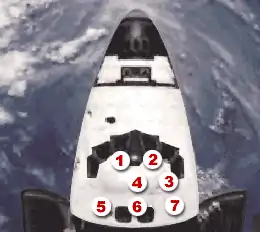 Seats 1–4 are on the Flight Deck. Seats 5–7 are on the Middeck. |
|---|---|---|---|
| S1 | Gregory | Gregory | |
| S2 | Blaha | Blaha | |
| S3 | Carter | Thornton | |
| S4 | Musgrave | Musgrave | |
| S5 | Thornton | Carter |
Mission background
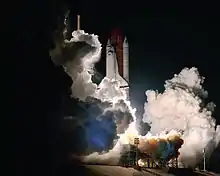
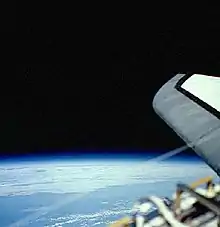
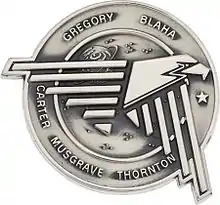
STS-33 was the original designation for the mission that became STS-51-L, the Challenger disaster. After Challenger's destruction, NASA recycled the mission numbering system back to STS-26, which was the 26th shuttle mission and the first to fly after the disaster.
S. David Griggs, a veteran of STS-51-D, was to have been the pilot of this mission. He was killed in the crash of a vintage World War II aircraft in June 1989 while training to serve as pilot on STS-33, and is commemorated on the mission insignia with a single gold star on the blue field.[2] He was replaced by John Blaha. Sonny Carter, a Mission Specialist on this flight, was killed in a commercial plane crash on 5 April 1991[3] while training to fly on STS-42.
Mission summary
STS-33 was originally scheduled to launch on 20 November 1989, but was delayed because of problems with the integrated electronics assemblies which controlled the ignition and separation of the shuttle's solid rocket boosters (SRBs). STS-33 was the third night launch of the Space Shuttle program, and the first since shuttle flights resumed in 1988 following the Challenger disaster of 1986.
During the mission, Discovery deployed a single satellite, USA-48 (1989-090B). Experts believe that this was a secret Magnum ELINT (ELectronic INTtelligence) satellite headed for geosynchronous orbit, similar to that launched by STS-51-C in 1985, making this mission essentially a duplicate of that earlier mission.[4] According to Jim Slade of ABC News, USA-48 was intended to eavesdrop on military and diplomatic communications from the Soviet Union, China, and other communist states. The satellite deployed by STS-33 was a replacement for the one launched by STS-51-C, which was running out of the maneuvering fuel required for keeping its station over the Indian Ocean.[5] However, astronaut Gary E. Payton stated in 2009 that STS-51-C's payload is "still up there, and still operating".[4]
Aviation Week claimed that during STS-33, the shuttle initially entered an 204 km (127 mi) x 519 km (322 mi) orbit at an inclination of 28.45° to the equator. It then executed three Orbital Manoeuvering System (OMS) burns, the last on its fourth orbit. The first burn was to circularize the orbit at 519 km (322 mi). The satellite was deployed on the seventh orbit, and ignited its Inertial Upper Stage (IUS) booster at the ascending node of the eighth orbit, successfully placing it in a geostationary transfer orbit (GTO). This was the eighth IUS launched aboard the shuttle, and the seventh successfully deployed.
STS-33 suffered a cabin leak in the Waste Collection System.[6]
STS-33 was observed by the 1.6 m (5 ft 3 in) telescope of the U.S. Air Force Air Force Maui Optical and Supercomputing observatory (AMOS) during five passes over Hawaii. Spectrographic and infrared images of the shuttle obtained with the Enhanced Longwave Spectral Imager (ELSI) were aimed at studying the interactions between gases released by the shuttle's primary reaction control system (RCS) and residual atmospheric oxygen and nitrogen species in orbit.[7][8]
The landing was initially scheduled for 26 November 1989, but was postponed for a day because of strong winds at the landing site. Discovery landed at Edwards Air Force Base, California, on 27 November 1989 at 7:30:16 p.m. EST, after a mission duration of 5 days, 0 hour, 6 minutes, and 46 seconds.
References
- "STS-33". Spacefacts. Retrieved 26 February 2014.
- Archived 23 November 2008 at the Wayback Machine
- "Carter". Astronautix.com. Archived from the original on 22 July 2010. Retrieved 12 August 2010.
- Cassutt, Michael (August 2009). "Secret Space Shuttles". Air & Space magazine. Retrieved 19 April 2015.
- Slade, Jim (22 November 1989). "ABC News Coverage of the STS-33 Launch". ABC News.
- "Space Shuttle Missions Summary" (PDF). NASA. September 2011. Archived from the original (PDF) on 9 July 2019.
 This article incorporates text from this source, which is in the public domain.
This article incorporates text from this source, which is in the public domain. - Knecht, David J. (19 April 1990). "Recovery of Images from the AMOS ELSI Data for STS-33" (PDF). Geophysics Laboratory (PHK), Hanscom AFB.
 This article incorporates text from this source, which is in the public domain.
This article incorporates text from this source, which is in the public domain. - I.L. Kofsky; D.L.A. Rall; R.B. Sluder (28 June 1991). "Measurements and Interpretation of Contaminant Radiations in the Spacecraft Environment". Phillips Laboratory, Hanscom AFB.
 This article incorporates text from this source, which is in the public domain.
This article incorporates text from this source, which is in the public domain.
.jpg.webp)